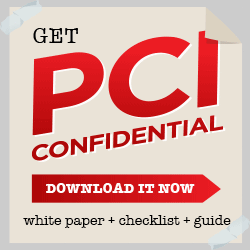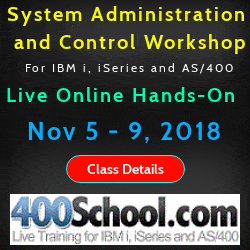
|
||
|
SecureMyi.com Security and Systems Management Newsletter for the IBM i
May 14, 2014 - Vol 4, Issue 8
|
||

|
||



|
Feature Article
|
|
In This Issue
Quick Links
Our Newsletter Sponsors
Platinum Sponsor |
IBM i Security ResourcesIBM i Security Videos - SecureMyi RedBook - Security Guide IBM i Open Security Foundation - DataLoss DB National Vulnerability Database - NIST 


|


|
Featured YouTube Educational VideoIBM i Security

Cannot Access YouTube from your office? Download the video in wmv format. |
||

|


|
|
Security Shorts - All Numeric Passwords and User IDsBy Dan Riehl - SecureMyi.com My UserID is 77 and My Password is 123456Naming rules for the IBM i state that an object name must begin with an alphabetic character including A-Z, #, $, @, and that the remaining characters (up to 10 in total) can contain A-Z, 0-9, #, $, @, _ ,and a .(period). The object names are not case sensitive. However, when it comes to user profile names and passwords, an interesting phenomenon occurs. When we create a user profile, we specify a user profile name and, optionally, we specify a password, as in the following example. (For these examples, we assume a Password Level (QPWDLVL) of 0 or 1, limiting a password to a maximum length of 10 characters.) CRTUSRPRF USRPRF(BOBSMITH) PASSWORD(PASS1WORD5) Now, when the user needs to log on, his user ID is BOBSMITH, and his password is PASS1WORD5. Simple and straightforward. But consider this next example: CRTUSRPRF USRPRF(Q12345) PASSWORD(Q11111) When a user profile is created using this command, the user can actually log on using two different user IDs and two different passwords. It's a bit weird, but let me explain.
The secret to this weird support lies in the first character of the user or password being the specific letter Q, followed only by digits. When this is the case, the letter Q becomes an optional part of the user or password during the system logon process. You can view more about this Q digit support by reviewing the F1=Help text of the CRTUSRPRF(Create User Profile) command. As the system administrator, you can enforce policy to disallow the creation of a Q digits user profile, but a user can change his or her password to a Q digits password using the Change Password (CHGPWD) command and/or Change Password API. In order to restrict users from setting their passwords to Q digits (e.g., Q11111), you can either set the system value QPWDLMTAJC to the value 1 or include the value *DGTLMTAJC in the system value QPWDRULES. Either of these settings prohibit the use of adjacent digits in a password when changed by the user. |
Sponsored Links
IBM i, iSeries and AS/400
|
|

|
||

|
||
|
Send your IBM i Security and Systems Management News and Events! Send your Questions, Comments, Tips and Stories Copyright 2014 - SecureMyi.com, all rights reserved SecureMyi.com | St Louis MO 63017 |
||